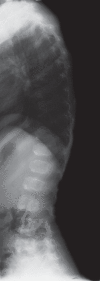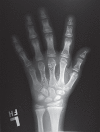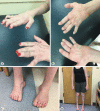Combined Phenotypes of Spondylometaphyseal Dysplasia-Kozlowski Type and Charcot-Marie-Tooth Disease Type 2C Secondary to a TRPV4 Pathogenic Variant
- PMID: 31191204
- PMCID: PMC6528083
- DOI: 10.1159/000495778
Combined Phenotypes of Spondylometaphyseal Dysplasia-Kozlowski Type and Charcot-Marie-Tooth Disease Type 2C Secondary to a TRPV4 Pathogenic Variant
Abstract
TRPV4, a nonselective calcium permeable ion channel, is expressed broadly in many organs including bone and neurons. Pathogenic variants in TRPV4 are known to cause both a spectrum of skeletal dysplasias and neuropathies. Recent publications have documented a few patients who have a combined phenotype of skeletal dysplasia and neuropathy secondary to TRPV4 pathogenic variants. We present an additional patient who has an overlapping neuromuscular and skeletal phenotype secondary to a TRPV4 pathogenic variant. The patient has spondylometaphyseal dysplasia-Kozlowski type and Charcot-Marie-Tooth disease type 2C. This and prior reports illustrate that TRPV4-related skeletal dysplasias and TRPV4-related neuropathies are not fully distinct disorders secondary to unique sets of pathogenic variants as originally postulated, but rather are 2 phenotypes on the same spectrum that may or may not overlap. We suggest that evaluation for patients presenting with any TRPV4-related disorder include assessment for both skeletal and neurological findings.
Keywords: CMT2C; Charcot-Marie-Tooth; SMD-K; Spondlyometaphyseal dysplasia Kozlowski; TRPV4.
Figures




Similar articles
-
Natural history of TRPV4-Related disorders: From skeletal dysplasia to neuromuscular phenotype.Eur J Paediatr Neurol. 2021 May;32:46-55. doi: 10.1016/j.ejpn.2021.03.011. Epub 2021 Mar 16. Eur J Paediatr Neurol. 2021. PMID: 33774370
-
Protein informatics combined with multiple data sources enriches the clinical characterization of novel TRPV4 variant causing an intermediate skeletal dysplasia.Mol Genet Genomic Med. 2019 Mar;7(3):e566. doi: 10.1002/mgg3.566. Epub 2019 Jan 28. Mol Genet Genomic Med. 2019. PMID: 30693671 Free PMC article.
-
Comparison of the natural course of clinical and radiologic features in 13 patients with TRPV4-related skeletal dysplasias.Pediatr Radiol. 2025 Mar;55(3):505-519. doi: 10.1007/s00247-024-06145-7. Epub 2025 Jan 18. Pediatr Radiol. 2025. PMID: 39825918
-
TRPV4-associated skeletal dysplasias.Am J Med Genet C Semin Med Genet. 2012 Aug 15;160C(3):190-204. doi: 10.1002/ajmg.c.31335. Epub 2012 Jul 12. Am J Med Genet C Semin Med Genet. 2012. PMID: 22791502 Review.
-
TRPV4-pathy, a novel channelopathy affecting diverse systems.J Hum Genet. 2010 Jul;55(7):400-2. doi: 10.1038/jhg.2010.37. Epub 2010 May 27. J Hum Genet. 2010. PMID: 20505684 Review.
Cited by
-
Exploring and expanding the phenotype and genotype diversity in seven Chinese families with spondylo-epi-metaphyseal dysplasia.Front Genet. 2022 Aug 31;13:960504. doi: 10.3389/fgene.2022.960504. eCollection 2022. Front Genet. 2022. PMID: 36118854 Free PMC article.
-
Identification and Properties of TRPV4 Mutant Channels Present in Polycystic Kidney Disease Patients.Function (Oxf). 2024 Sep 10;5(5):zqae031. doi: 10.1093/function/zqae031. Function (Oxf). 2024. PMID: 38984987 Free PMC article.
-
Impaired neurite development and mitochondrial dysfunction associated with calcium accumulation in dopaminergic neurons differentiated from the dental pulp stem cells of a patient with metatropic dysplasia.Biochem Biophys Rep. 2021 Mar 9;26:100968. doi: 10.1016/j.bbrep.2021.100968. eCollection 2021 Jul. Biochem Biophys Rep. 2021. PMID: 33748438 Free PMC article.
-
Transient Receptor Potential Vanilloid in the Brain Gliovascular Unit: Prospective Targets in Therapy.Pharmaceutics. 2021 Mar 4;13(3):334. doi: 10.3390/pharmaceutics13030334. Pharmaceutics. 2021. PMID: 33806707 Free PMC article. Review.
-
TRPV4 mutations causing mixed neuropathy and skeletal phenotypes result in severe gain of function.Ann Clin Transl Neurol. 2022 Mar;9(3):375-391. doi: 10.1002/acn3.51523. Epub 2022 Feb 16. Ann Clin Transl Neurol. 2022. PMID: 35170874 Free PMC article.
References
-
- Cho TJ, Matsumoto K, Fano V, Dai J, Kim OH, et al. TRPV4-pathy manifesting both skeletal dysplasia and peripheral neuropathy: a report of three patients. Am J Med Genet A. 2012;158A:795–802. - PubMed
-
- Dai J, Cho TJ, Unger S, Lausch E, Nishimura G, et al. TRPV4-pathy, a novel channelopathy affecting diverse systems. J Hum Genet. 2010;55:400–402. - PubMed
Publication types
LinkOut - more resources
Full Text Sources

